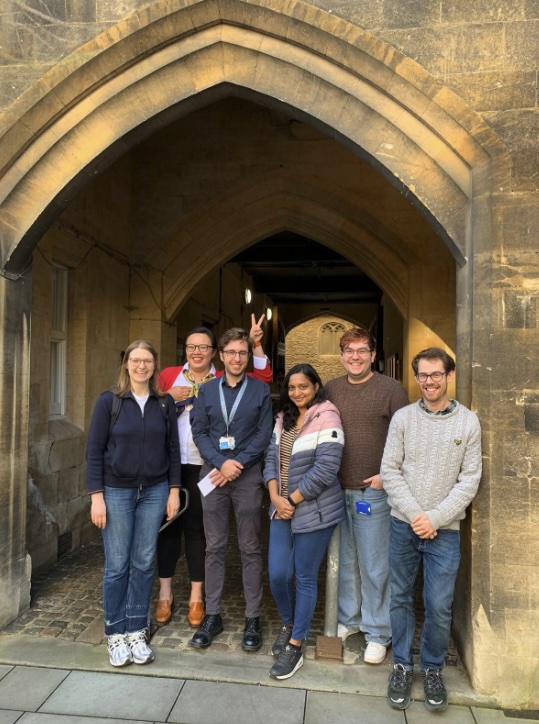Biography
My research is centred around the translational control of protein synthesis – an essential biological process in all living organisms. Translational regulation is widespread and especially important in the cellular response to stress factors, growth cues and differentiation signals. After undergraduate studies in Biochemistry at the University of Otago, Dunedin, New Zealand, I pursued a PhD in Biochemistry at University College Cork, Ireland where I focused on elucidating non-canonical gene expression mechanisms in RNA viruses. During this time, I discovered and characterised novel mechanisms viruses use to generate previously unknown, but essential factors for infection.
With support from Long-Term EMBO and Sir Henry Wellcome Postdoctoral Fellowships, I joined the Baulcombe Lab in the Department of Plant Sciences at the University of Cambridge. There, I elucidated the ancestral mechanism of miRNA-mediated translational regulation using the green algae Chlamydomonas reinhardtii as a model organism. Subsequently, through a Medical Research Council Career Development Fellowship, I established my research group within the Department of Pathology. Our primary focus is on investigating the molecular mechanisms of gene expression and translational control at the host-pathogen interface across various domains of life, particularly in the animal and plant kingdoms, and across multiple pathogen systems including viruses, bacteria, and eukaryotic parasites.
Our recent discoveries include the rapid translational induction of sentinel cells in response to osmotic changes as a mechanism to overcome infection, and the identification of novel translation mechanisms in pathogenic bacteria. My long-term scientific vision is to understand how living organisms utilise novel gene expression mechanisms to respond and adapt to the challenging and complex biosystems we live in, and how we can use these molecular discoveries to engineer biological systems for biotechnological applications to combat pathogen infection in the face of climate change.
Research
Group members:
Dr Sherine Thomas
Dr Filip Lastovka
Dr George Wood
Dr Sam Crawshaw
Visiting scientists
Dr Mariya Lobanovska (UC Berkeley, Portnoy Lab)
Dr Eugenio Solchaga (Department of Biochemistry, Luisi Lab)
Dr Alex Murphy (Department of Plant Sciences, Carr Lab)
Dr Jessica Bergman (Department of Plant Sciences, Carr Lab)
Dr Andrew Yep (Department of Plant Sciences, Carr Lab)
Publications
Public resource development
riboSeqR – Bioinformatic software package developed with Dr Thomas Hardcastle as part of the Bioconductor project, to assist the community in the analysis of Ribosome Profiling data [Hardcastle and Chung 2023; Chung et al. 2015 RNA]
Preprints
- Dominykas Murza, Filip Lastovka, George Wood, Matthew P. Brember, Ollie Chan, James W. Ajioka, Betty Y. W. Chung (2025) Toxoplasma strikes preemptively to swiftly suppress macrophage immune response during active infection DOI:10.1101/2025.01.31.635863
- Lo, I., Lastovka, F., Singh, P., Schreier, T., Chung, B #. (Co-corresponding) and Hibberd, J.M, #. (2023) Pervasive translational control of photosynthesis genes during photomorphogenesis is acquired by C4genes DOI: 10.1101/2023.10.27.563924
- Wood, G*., Johnson, B*., Brember, M., Lastovka F., Tourlomousis, P., Bryant, C. #. and Chung, B #. (2024)Activity of Salmonella SPI-1 inhibits the TLR4-dependent transcriptional but not translational response during macrophage infection DOI:10.1101/2024.01.08.574706
- Lastovka. F., Peyret. H., Thomas. S., , Lomonossoff. G#., Betty Y.-W. Chung#. (2024) Controlling heterologous protein synthesis through a plant RNA ThermoSwitch DOI: 10.1101/2024.10.07.616989
Book chapters, reviews and protocols
- Lastovka. F., Peyret. H., Lomonossoff. G#., Betty Y.-W. Chung#. (2025) RNA elements and their biotechnological applications in plants DOI: 10.1111/nph.70400
- Balcerowicz, M., Wigge, P., Di Antonio, M., Chung, B. (2023) Monitoring Real-Time Temperature Dynamics of a Short RNA Hairpin Using Forster Resonance Energy Transfer and Circular Dichroism. Methods in Molecular Biology DOI:10.1007/978-1-0716-3814-9_15
- Thomas, S., Balcerowicz, M., Chung, B. (2022) RNA structure mediated thermoregulation: What can we learn from plants? Frontiers in Plant Sciences DOI: 10.3389/fpls.2022.938570
- Balcerowicz, M., Di Antonio, M., Chung, B. (2021) Hairpin temperature-dependent FRET. Bio protocol DOI:10.21769/BioProtoc.3950
Peer reviewed publications
- Wood, G., Powell J., Johnson, B., Lastovka F., Bryant, O., Brember, M., Tourlomousis, P., Carr, J.P., Bryant, C. and Chung, B. (2025) Salmonella injectisome penetration of macrophages triggers rapid translation of transcription factors and protection against cell death DOI:10.1101/2023.07.21.550113, Nature Communications (in press)
This study uncovers a rapid translational response mounted by macrophages to combat bacterial pathogens possessing a type III secretion system (injectisome). It demonstrates that host cells engage in selective translational reprogramming as an early and effective defence mechanism and offer important new insights into innate immunity and the cellular strategies underlying resilience to infection.
- Wood, G., Lastovka, F., Murza, D., Brember, M., McGovern, M., and Chung, B. (2025) An RNA-based dual-fluorescence reporter system reveals cell-type specific and temporal dynamics of -1 programmed ribosomal frameshifting. Journal of Molecular Biology DOI:10.1016/j.jmb.2025.169371
- Yoshida, N., Appois, A., Li, Q., Hutton, J., Wood. G., Potts. M., Aleksandrowicz. J., Barrozo. E., Dover. F., Andreson. H., Stephens, K., Aye. I., Thomas. J., Schenk, H., Bourke. A., Aiken. C., Moffett. A., Sharkey. A., Protasio. A., Aagaard. K., Edgar. J., Chung. B# (co-corresponding)., McGovern. N#. (2025) Interactions between placental Hofbaur cells and L. monocytogenes change throughout gestation. Science Immunology (in press)
- Ravenhill, B.,J, Oliveira O., Wood, G.,, Di, Y., Davies, C,. Lu, Y., Antrobus, R., Elliott, G., Irigoyen, N., Hughes, D.J., Lyons, P., Chung, Y-W., Borner, G., and Weekes M.P. (2024) Spatial proteomics identifies a novel CRTC-dependent viral sensing pathway that stimulates production of Interleukin-11 Cell Reports DOI: 10.1016/j.celrep.2025.115263
- Yoshida N, Thomas JR, Appios A, Brember MP, Aye ILMH, Edgar JR, Firth AE, Chung BYW, McGovern N, Stewart H (2024) Human placental cells are resistant to SARS-CoV-2 infection and replication. Wellcome Open Res 9:209.
- Bryant, O*., Lastovka, F*., Powell, J., Chung, B. (2023) The distinct translational landscape of Gram-positive and Gram-negative bacteria. Nature Communications DOI: 10.1101/2023.05.25.542305
First high-definition ribosome profile of any wild-type bacterial system; Discovery of novel cis-regulatory elements in Gram negative bacteria that drives efficient translation; Discovery of novel translation initiation mechanism in the Gram positive bacteria Listeria.
- Thomas, S., Balcerowicz, M., Chung, B. (2022) RNA structure mediated thermoregulation: What can we learn from plants? Frontiers in Plant Sciences DOI: 10.3389/fpls.2022.938570
- Albarnaz, J., Ren, H.,, Torres, A.A., Shmeleva, E.V., Melo, C.A., Bannister, A.J., Brember, M.P., Chung, B.Y.W., Geoffrey L. Smith G.L. (2021) Viral mimicry of p65/RelA transactivation domain to inhibit NF-κB activation. Nature Microbiology DOI: 10.1038/s41564-021-01004-9
- Dumetz, F., Chow, E., Harris, L., Umar, M., Jensen, A., Chung, B., Chan, T., Merrick, C., Kwok, K., (2021) G-quadruplex RNA motifs influence gene expression in the malaria parasite Plasmodium falciparum. Nucleic Acids Research DOI:10.1093/nar/gkab1095
- Balcerowicz, M., Di Antonio, M., Chung, B., (2021) Hairpin temperature-dependent FRET. Bio-protocol DOI:10.21769/BioProtoc.3950
- Pearce, S., Cipullo, M., Chung, B., Brierley, I., Rorbach, J. (2021) Mitoribosome Profiling from Human Cell Culture: A High Resolution View of Mitochondrial Translation. Methods in Molecular Biology: Mitochondrial Gene Expression. 2192:p183-196 DOI:10.1007/978-1-0716-0834-0_14
- Chung, B. (co-corresponding), Balcerowicz M, Antonio M.D., Jaeger K.E., Geng F., Franaszek K., Marriott P., Brierley I., Firth A.E., Wigge P.A., (2020) An RNA thermoswitch regulates daytime growth in Arabidopsis. Nature Plants, May;6(5):522-532, DOI: 10.1038/s41477-020-0633-3,
First case of an eukaryotic RNA ThermoSwitch that controls protein synthesis. May issue with an accompanying News and Views highlight. Selected for Faculty of 1000. Hot and highly cited by Thompson Reuter.
- Chung, B. (co-corresponding), Molnar, A., Deery M., Valli, A., Hardcastle, T., Howard J. and Baulcombe, D. (2019) Distinct roles of Argonaute in the green alga Chlamydomonas reveal an evolutionarily conserved mode of miRNA-mediated gene regulation. Sci. Rep., 9:22091, DOI:10.1038/s41598-019-47415-x
Part II of Chlamydomonas miRNA story – provides an explanation of miRNA CDS targeting and its evolutionary importance.
- Chung, B. (co-corresponding), Deery, M., Groen, A., Howard, J., and Baulcombe, D. (2017) Endogeneous miRNA in the green alga Chlamydomonasregulate translation repression through CDS-targeting. Nature Plants. Oct; 3(10):787-794 DOI:10.1038/s41477-017-0024-6
October issue with an accompanying News and Views highlight. First demonstration of the global effects and targeting efficacy of endogenous miRNA on gene expression in plants.
- Valli, A., Santos, B., Hnatova, S., Bassett, A., Molnar, A., Chung, B., and Baulcombe, D. (2016) Most microRNAs in the single-cell alga Chlamydomonas reinhardtiiare produced by Dicer like 3- mediated cleavage of introns and untranslatable regions of coding RNAs. Genome Research26(4): 519-529, DOI: 10.1101/gr.199703.115
- Irigoyen, N., Firth, A., Jones, J., Chung, B., Siddell, S., and Brierley, I. (2016) High-resolution analysis of Coronavirus gene expression through RNA sequencing and ribosome profiling. PLoS Path.12(2):e1005473. DOI: 10.1371/journal.ppat.1005473
- Chung, B. (co-corresponding), Hardcastle, T., Jones, J., Irigoyen, N., Firth, A., Baulcombe, D., and Brierley, I. (2015) The use of duplex-specific nuclease in ribosome profiling and a user-friendly software package for Ribo-Seq data analysis. RNA, 21: 1731-1745, DOI: 10.1261/rna.052548.115
Development of a non-organism specific rRNA depletion method for ribosome profiling and a software package for simultaneous analysis of paired ribosome profiling and RNA-seq.
- Olspert, A., Chung, B., Carr, J., and Firth, A. (2015) Transcriptional slippage in the positive-sense RNA virus family Potyviridae. EMBO Rep, 16: 995-1004,with an accompanying News and Views highlight DOI: 10.15252/embr.201540509
Deciphered the non-canonical expression mechanism of P3N-PIPO, an overlapping gene in the largest plant virus family.
- Smirnova, E., Firth, A., Scheidecker, D., Brault, V., Reinbold, C., Rakotondrafara, A., Chung, B., Miller, W., and Ziegler-Graff, V. (2015) Discovery of a small non-AUG-initiated ORF in Poleroviruses and Luteoviruses that is required for long-distance movement. PLoS Path, 11: e1004868, DOI: 10.1371/journal.ppat.1004868
- Cook, A., Chung, B. (joint first author), Bass, D., Moureau, G., Mcalister, E., Culverwell, L., Glucksman, E., Wang, H., Brown, T., Gould, E., Harbach, R., De Lamballerie, X. and Firth, A. (2013)Novel virus discovery and genome reconstruction from field RNA samples reveals highly divergent viruses in dipteran hosts. PLoS ONE, 8: e80720, DOI: 10.1371/journal.pone.0080720
- Kuchibhatla, D., Sherman, W., Chung, B., Cook, S., Schneider, G., Eisenhaber, B. and Karlin, D. (2013) Powerful sequence similarity search methods and in-depth manual analyses identify remote homologs in many apparently “orphan” viral proteins. J Virol88: 10-20, DOI:10.1128/JVI.02595-13
- Chung, B., Firth, A. and Atkins, J. (2010) Frameshifting in Alphaviruses: a diversity of 3′ stimulatory structures. J Mol Biol, 397: 448-456. DOI:10.1016/j.jmb.2010.01.044
Characterization of cis-elements utilized for programmed ribosome frameshifting in Alphaviruses.
- Firth, A., Chung, B. (joint first author), Fleeton, M. and Atkins, J. (2008) Discovery of frameshifting in Alphavirus 6K resolves a 20-year enigma. Virol J, 5: 108, DOI: 10.1186/1743-422X-5-108
Discovery of the overlapping gene (TF) in the important animal virus Alphavirus genus as well as characterization of its non-canonical expression mechanism via ribosome frameshifting.
- Chung, B., Miller, W., Atkins, J., and Firth, A. (2008) An overlapping essential gene in the Potyviridae. Proc Natl Acad Sci, 105: 5897-5902, DOI: 10.1073/pnas.0800468105,
Selected by Faculty of 1000. Discovery of an essential overlapping gene in the largest plant virus family.
- Chung, B., Simons, C., Firth, A., Brown, C. and Hellens, R. (2006) Effect of 5′ UTR introns on gene expression in Arabidopsis thaliana, Genomics, 7: 120, DOI: 10.1186/1471-2164-7-120



